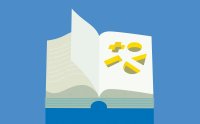Connecting Math and Science to Reading and Writing
Educators in K-12 classrooms are exploring unique ways to bridge the gap between math, science, and literacy.
Your content has been saved!
Go to My Saved Content.In high school math, where there has been a longstanding focus on calculus as a STEM-track prerequisite, the notion of emphasizing statistics and data literacy instead—which many educators say are more useful skills in the modern era—is the subject of ongoing debate.
“So much public policy research on topics like health care, the environment, taxes, and civil rights is generated using methods derived from statistics, not calculus,” writes Stephen Sawchuck for Education Week. “The explosion of online information of varying quality means that good citizenship now hinges on being able to analyze a tsunami of statistics, graphics, and numbers—both to test competing claims, and to advance new solutions and ideas in the civic space.”
To prepare students to distinguish between the cascade of true and false narratives—many of which make questionable claims to truth based in pseudoscience or bad math—some teachers focus on integrating mathematical, statistical, and scientific concepts with other subjects. By weaving together civics or social studies and math, students get used to working through complex arguments using the finer points of these disciplines.
Alison Strole, a middle-school math teacher in Fishers, Ind., asks her students to analyze two decades worth of exit-poll results from U.S. elections, collected from a variety of sources, including CNN’s 2016 exit polls here or 270ToWin.com state-by-state historical election results here. “Officially, this is part of her math unit on data analysis and how to read and interpret two-way data tables, part of 7th- and 8th-grade algebra,” Sawchuck writes. “In practice, it’s also a powerful civics lesson…[that] illustrates a potential missing piece in the national conversation about improving civics education: How math can be harnessed toward schools’ goal of readying youths for engaged citizenship.”
SOLAR POWER PROJECT
In another approach to teaching her students quantitative literacy skills, Strole’s students worked on a project based on a real-life problem at the intersection of science, civics, and math: their school had recently installed solar panels. “She asked students to do a cost analysis on the costs and benefits of sticking with electric versus purchasing or leasing solar panels—and even whether the school’s solar energy production was on track to help the city meet the United Nations’ goal for renewable energy by 2030,” Sawchuck writes. To wrap up the project, Strole’s students wrote letters to the mayor and their district energy manager suggesting how the city might meet the UN renewable energy goals.
Asking students to write in all their classes can boost not only critical thinking skills, but also drive greater achievement across all subjects. Teachers can dip a toe into the practice, according to Seth Andrews, founder of the Democracy Prep network of charter schools, by weaving civics data into word problems—for instance, using 435, the number of U.S. House representatives, as the denominator in fraction questions. As students mature, teachers can make things more challenging by asking them to regularly include math and science data in essays to bolster arguments.
WRITING A MATH MAGAZINE
In Bethesda, Md., middle-school math coordinator Alessandra King often draws on reading and writing to offset what she describes as the increasingly abstract nature of math curriculum in middle and high school.
“Reading and writing are complex, fundamental, integrative learning skills that should be used to their potential in math class,” King wrote. While using writing prompts in elementary and middle school math classes isn’t exactly new, King employs these skills for a different purpose: she uses reading and writing to show her students how math exists in everyday life. “One assignment that I’ve found effective is having students create a magazine of excerpts of articles about various applications of mathematics in real life,” writes King. For this project, she asks her students to select articles that interest them, read and summarize them, and then post their summaries in an online magazine that they create. “This has been one of my most popular projects—students are amazed to discover some of the myriad applications of math.”
In addition to blogs, websites, podcasts, and videos, her go-to resources include The Washington Post, The New York Times, The Economist, New Scientist, Scientific American, and The Atlantic. She’s a big fan of MathFeed (a free download from the Apple App store) which provides a curated feed of news and opinion pieces involving math in the media.
THE CHALLENGES OF INTERDISCIPLINARY TEACHING
While the idea of exploring interdisciplinary connections like these to deepen student learning is a popular idea among educators, says Sawchuck, there are challenges schools and teachers need to be aware of. Proprietary lessons related to the practice can be expensive, and curricula provided by school districts might not contain the supports teachers need. Also, teachers, who usually earn a degree or certification in one area, might not have sufficient content knowledge to combine disciplines. And of course, quality is another potential red flag: “There is legitimate concern, even among those sympathetic to the idea, that interdisciplinary lessons can muddle the teaching of both subjects.”
For teachers like Strole—whose math students, after analyzing twenty years’ worth of exit poll results, are required to write a data-analysis paper from the perspective of a campaign strategist for either the Republican or Democratic party—an interdisciplinary approach to learning is critical for getting students college and career ready. “We live in a bubble on social media with people with like-minded opinions,” she tells Sawchuk. “I want them to open it up and see both sides to arguments, and be able to support theirs with more than an opinion. And in my classroom, the support is the math.”
